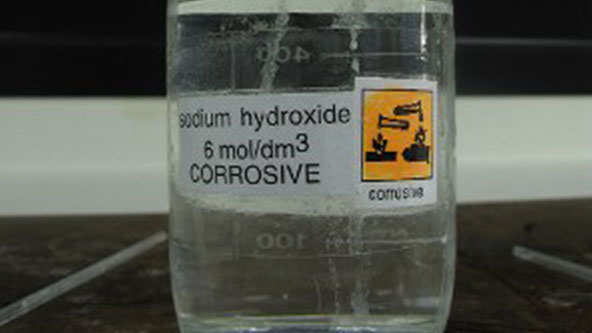Sodium Hydroxide (Lye) Safety
Posted on April 21, 2014 | in Safety

Used many years ago in soaps, sodium hydroxide – also known as lye – is still a widely used chemical today. Its uses range from food processing to petroleum refining, but it can be a very dangerous chemical. Here we’ll examine its usual uses, and the specific properties that make sodium hydroxide a threat to safety.
(Photo: Sodium Hydroxide 6mol Corrosive Lab Chemicals by Maticulous)
What Is Sodium Hydroxide and how is it Used?
Sodium hydroxide is an odorless, inorganic compound that serves as a metallic base for many types of chemicals, particularly in the paper and textiles industries, food processing, soaps, detergents and cleaners. Made from the chemical formula NaOH – an alkali that is made from a hydroxyl ion attaching to a sodium ion – sodium hydroxide is a white solid that can come in several forms, including pellets, flakes, granules and prepared solutions. Solutions mixed using sodium hydroxide come in different concentrations, the most common being a 50 percent saturated solution with water.
The Benefits of Sodium Hydroxide
Sodium hydroxide is highly soluble in water, ethanol and methanol, making it an excellent compound to mix with these liquids. It is also a deliquescent, meaning it has strong absorption capabilities, so it easily and quickly absorbs moisture and carbon dioxide in the air. Because of these chemical attributes, major uses for sodium hydroxide are:
- As an aqueous solution
- Use in the chemical industry
- Creation of sodium salts
- Detergents
- pH regulation
- Aluminum production
- Increasing the alkalinity of a mixture
- Neutralizing acids
- Food processing (peeling vegetables, processing cocoa, soaking olives)
- Removing impurities from oil
- As an additive in drain declogging formulas
- Part of the paper-making process
Hazards Associated with Using Sodium Hydroxide
As stated previously, sodium hydroxide is highly caustic, but it is not currently classified as a carcinogen. However, it can cause serious damage when not handled safely.
The two most common ways to become injured by sodium hydroxide is either by contact (skin or eyes), or by inhaling a vapor containing high levels of the compound. The following injuries can occur when coming into direct contact with undiluted sodium hydroxide:
- Ulceration of the nasal passages
- Irritation of the skin, eyes, lungs or nasal passages
- Eye and skin burns, sometimes severe
- Esophageal burns if swallowed
- Blindness
Best Practices with Sodium Hydroxide
The wearing of protective gear can help prevent serious injury from sodium hydroxide. Here are some suggestions on what to wear both at home and at work:
- Respirator
- Boots
- Long rubber gloves
- Industrial aprons
- Overalls
- Chemical safety goggles
- Face shield
- Use of an eye wash fountain in work places
- Use of quick-drench systems in work areas
In addition to protective gear, NIOSH recommends that the maximum exposure to sodium hydroxide should be no higher than 10mg.
Safety Comes First When Handling Sodium Hydroxide
Sodium hydroxide is present in so many items it is virtually unavoidable. While it does not pose a large threat to the vast majority of people, it is a chemical that can cause serious damage in certain circumstances. By paying attention and taking the necessary steps to be physically protected, you can make sure your exposure doesn’t leave lifetime damage. Learn more about sodium hydroxide and more by visiting our online MSDS library.